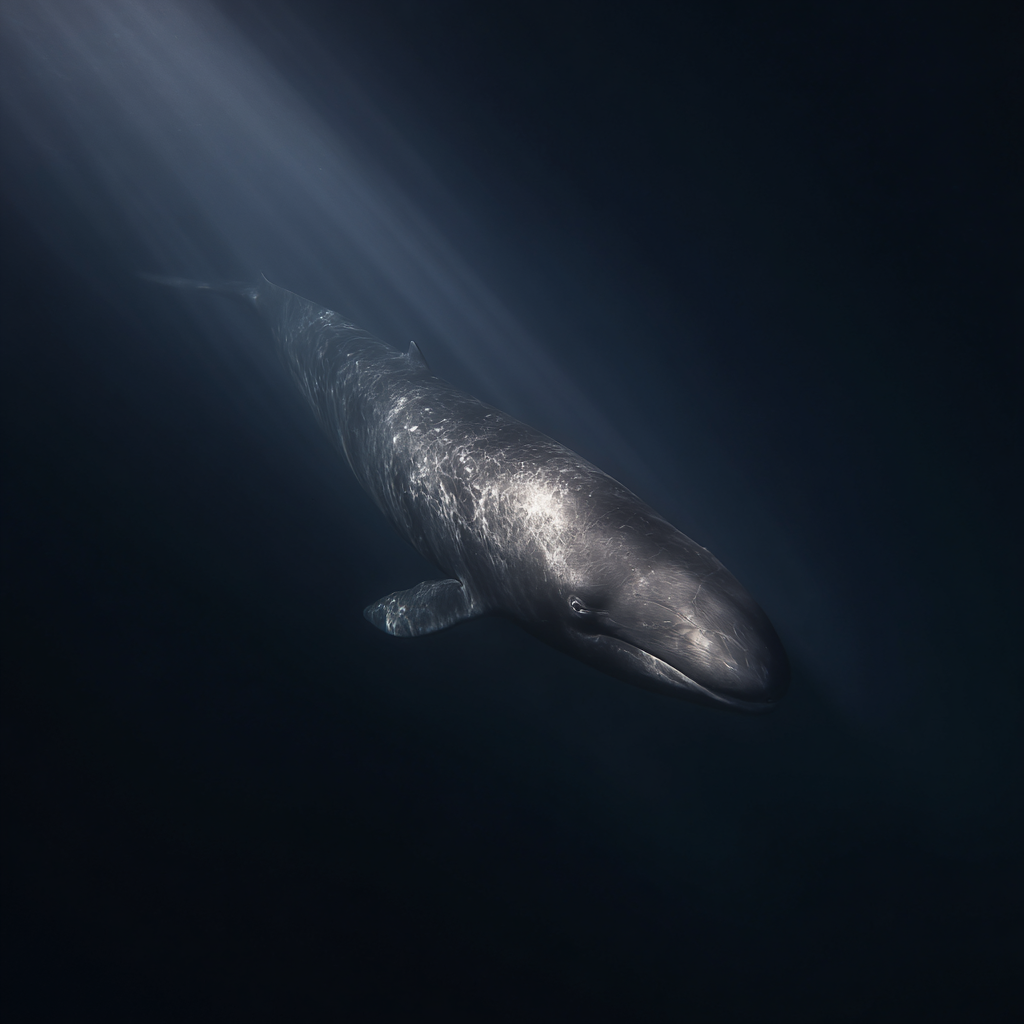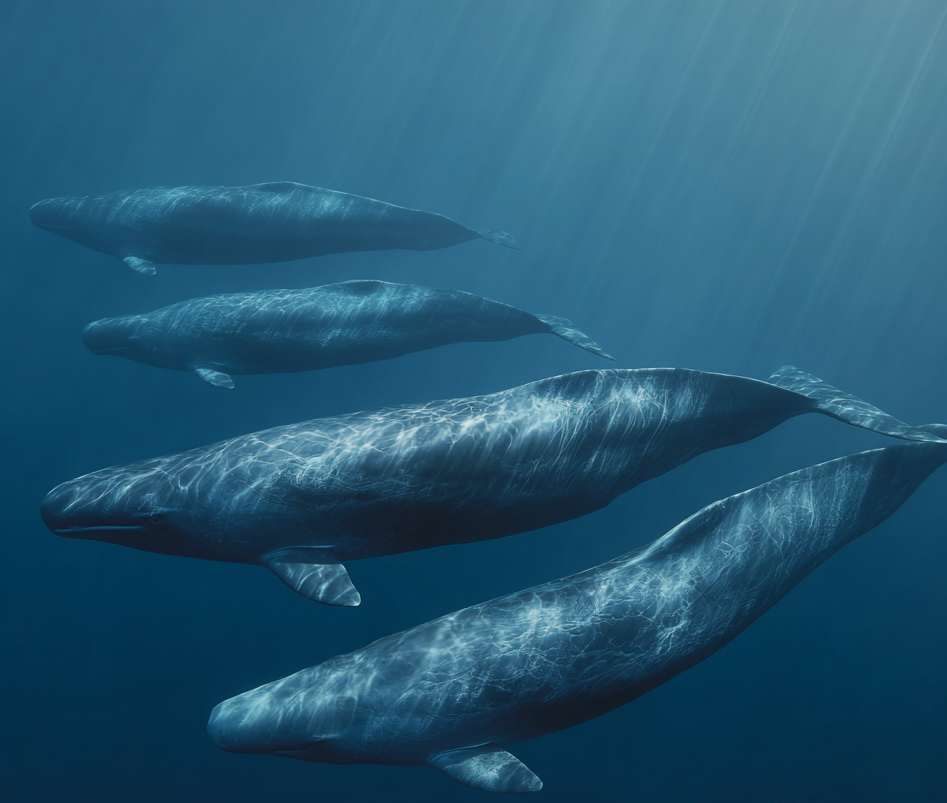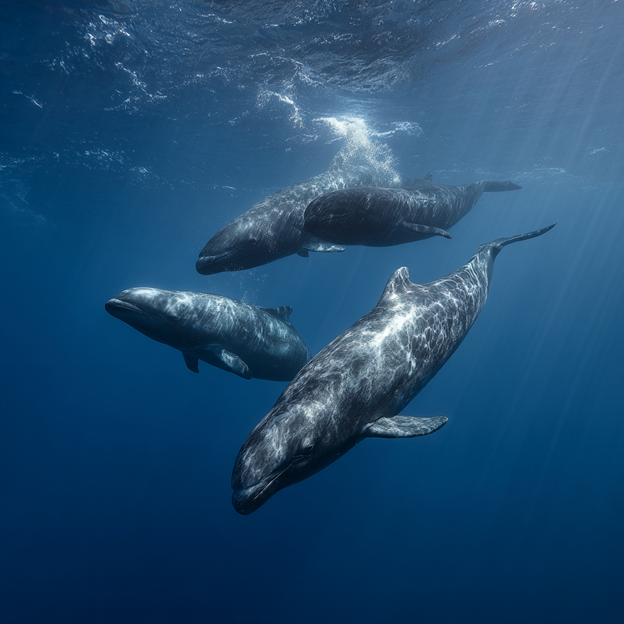Cuvier's Beaked Whale, Ziphius cavirostris, is a creature of the extreme deep, an animal so perfectly adapted to the crushing pressures of the abyss that it holds the mammalian records for both the deepest and longest dives. Its life is a profound mystery, spent thousands of meters below the surface in a world without light. This elusive nature has kept it largely hidden from human science, but its ghostly presence has long been felt in our stories. In ancient times, the fear of what lurked in the deep gave rise to myths of colossal sea monsters, like the Aspidochelone, that could swallow ships whole. Today, a new and tragic mystery surrounds this whale: its extreme sensitivity to the underwater noise of military sonar, which has been linked to a series of mass strandings, turning the modern ocean into a perilous place for this master of the deep.
I. Biological Snapshot: A Scientific Profile
- Scientific Name / Genus: Ziphius cavirostris, Genus Ziphius, Family Ziphiidae
- Recognized Species & IUCN Status:
- Species: Ziphius cavirostris
- IUCN Status: Least Concern (globally). However, the Mediterranean subpopulation is listed as Vulnerable.
- Physical Characteristics:
- Length: Up to 7.5 meters (25 ft).
- Weight: Up to 3,000 kg (3 tonnes).
- Lifespan: Up to 60 years.
- Distinguishing Features: A robust, cigar-shaped body that ranges from dark gray to reddish-brown, often covered in linear scratches (from male-on-male fighting) and circular scars (from cookie-cutter sharks). The head is short and blunt with a distinctive "smile" from the upcurved mouthline. Adult males often have a white head and two small, tusk-like teeth that erupt from the tip of the lower jaw.
- Global Population: Unknown, but it is considered one of the most abundant and widespread beaked whale species.
- Distribution & Habitat: A cosmopolitan species found in deep, offshore waters of all oceans, from the tropics to subpolar regions. They are rarely found in polar seas and prefer waters deeper than 1,000 meters.
- Diet & Foraging: A deep-diving predator that feeds primarily on deep-sea squid, supplemented with fish and crustaceans. It uses suction to capture prey in the dark depths.
- Reproduction: The life history of this species is very poorly known. Calves are about 2.7 meters long at birth. Females are thought to have a low reproductive rate, giving birth only every few years.

II. The Ancient Mystery: The Island Monster
For millennia, the deep ocean was a place of terror and myth for seafarers. In a world of small wooden ships, the abyss was an unknowable realm from which monsters could emerge. One of the most persistent of these legends was that of the Aspidochelone, a sea creature—sometimes described as a giant whale, other times a turtle—so colossal that its back was mistaken for an island.
According to medieval bestiaries and tales like the voyages of Sinbad the Sailor, weary sailors would spot what they believed to be a vegetated, sandy island, anchor their ships, and go ashore to make camp. But when they lit their fires, the great beast would feel the heat and awaken, plunging into the depths and dragging the ships and their crews to a watery grave. In Christian allegory, the Aspidochelone became a symbol of Satan, luring sinners to their doom with the false promise of safety.
While not a direct description of Cuvier's Beaked Whale, this myth perfectly captures the ancient human fear of the deep sea—the very world that this whale calls home. The Aspidochelone is the embodiment of the terrifying, hidden power of the abyss, a mystery that the elusive, deep-diving beaked whale represents in the natural world.

III. The Modern Tragedy: A Casualty of Sound
In the modern era, the ancient fear of sea monsters has been replaced by a new, and tragically real, threat to the inhabitants of the deep: anthropogenic noise. Cuvier's Beaked Whale has become the species most associated with the devastating impacts of military sonar. Since the 1960s, a series of "atypical" mass strandings, primarily involving this species, have been temporally and spatially linked to naval exercises using mid-frequency active sonar.
The exact mechanism remains a mystery, but the leading theory is that the intense sound triggers a profound behavioral response that is ultimately fatal. Necropsies on stranded whales have revealed evidence of gas-bubble lesions in their tissues, similar to decompression sickness, or "the bends," in human divers. It is believed that the sonar, which may sound like an approaching predator like an orca, causes the whales to panic. In their flight, they may alter their highly specialized dive patterns, ascending too quickly or making repeated shallow dives that cause nitrogen to form bubbles in their blood and organs, leading to disorientation, stranding, and death.
This modern tragedy has transformed the mythology of the deep. The monster is no longer the whale, but the invisible, inescapable sound that humans project into its silent world.

IV. Current Struggle: An Elusive Creature in a Noisy Ocean
The primary struggle for Cuvier's Beaked Whale is its extreme vulnerability to a rapidly changing and increasingly noisy underwater environment. Its elusive, deep-water nature makes it difficult to study, but the evidence from stranding events paints a clear picture of a species under severe acoustic stress.
| Primary Threat | Direct Impact | Synergistic Effects & Cascading Impacts | Ultimate Consequence |
|---|---|---|---|
| Ocean Noise | Extreme sensitivity to mid-frequency active sonar used in military exercises, as well as noise from seismic surveys and shipping. | Causes panic responses, disruption of foraging, and displacement from critical habitats. Believed to cause decompression sickness-like symptoms. | Atypical mass strandings and mortality events. |
| Entanglement | Accidental capture in fishing gear, such as deep-set nets and longlines. | Can cause severe injury, drowning, and starvation. | Direct, unnatural mortality. |
| Pollution & Debris | Ingestion of marine debris, particularly plastic bags mistaken for squid; bioaccumulation of chemical pollutants. | Can lead to internal blockages, starvation, and long-term health issues like reproductive failure. | Reduced health and resilience of individuals and populations. |
| Climate Change | Warming oceans may alter the distribution of their deep-water squid prey. | Forces whales to shift their ranges, potentially into areas with more anthropogenic threats like shipping lanes or naval exercise zones. | Increased risk of vessel strikes and noise exposure; potential for malnutrition. |
🌑 The West Direction Teaching 🌑
Cuvier's Beaked Whale embodies the West's deep mysteries—what we cannot see, what we fear in the darkness, and what we destroy through ignorance. The ancient Aspidochelone warned sailors of false islands; today's invisible monster is the sound we project into the abyss. The West asks: What terrors do we create in places we cannot see? What ancient wisdom lives in the depths beyond our understanding?
References & Further Reading
- IUCN Red List - Cuvier's Beaked Whale (Ziphius cavirostris)
- Nature Scientific Reports - Record-Breaking Dive Depths in Cuvier's Beaked Whales
- NOAA Fisheries - Cuvier's Beaked Whale Species Profile
- Medieval Bestiary - The Aspidochelone Legend
- JSTOR - Ancient Sea Monster Mythology and Maritime Culture
- PLOS ONE - Behavioral Response of Beaked Whales to Sonar
- Marine Mammal Science - Naval Sonar and Beaked Whale Mass Strandings
- Royal Society - Gas-Bubble Lesions in Stranded Cetaceans
- Endangered Species Research - Sonar-Induced Decompression in Marine Mammals
- Aquatic Mammals - Acoustic Sensitivity in Deep-Diving Cetaceans
- Cascadia Research Collective - Cuvier's Beaked Whale Biology
- Journal of Cetacean Research and Management - Beaked Whale Studies
- World Wildlife Fund - Beaked Whale Conservation
- Ocean Conservancy - Military Sonar as a Threat to Marine Life
- BioScience - Deep-Diving Marine Mammals and Anthropogenic Noise